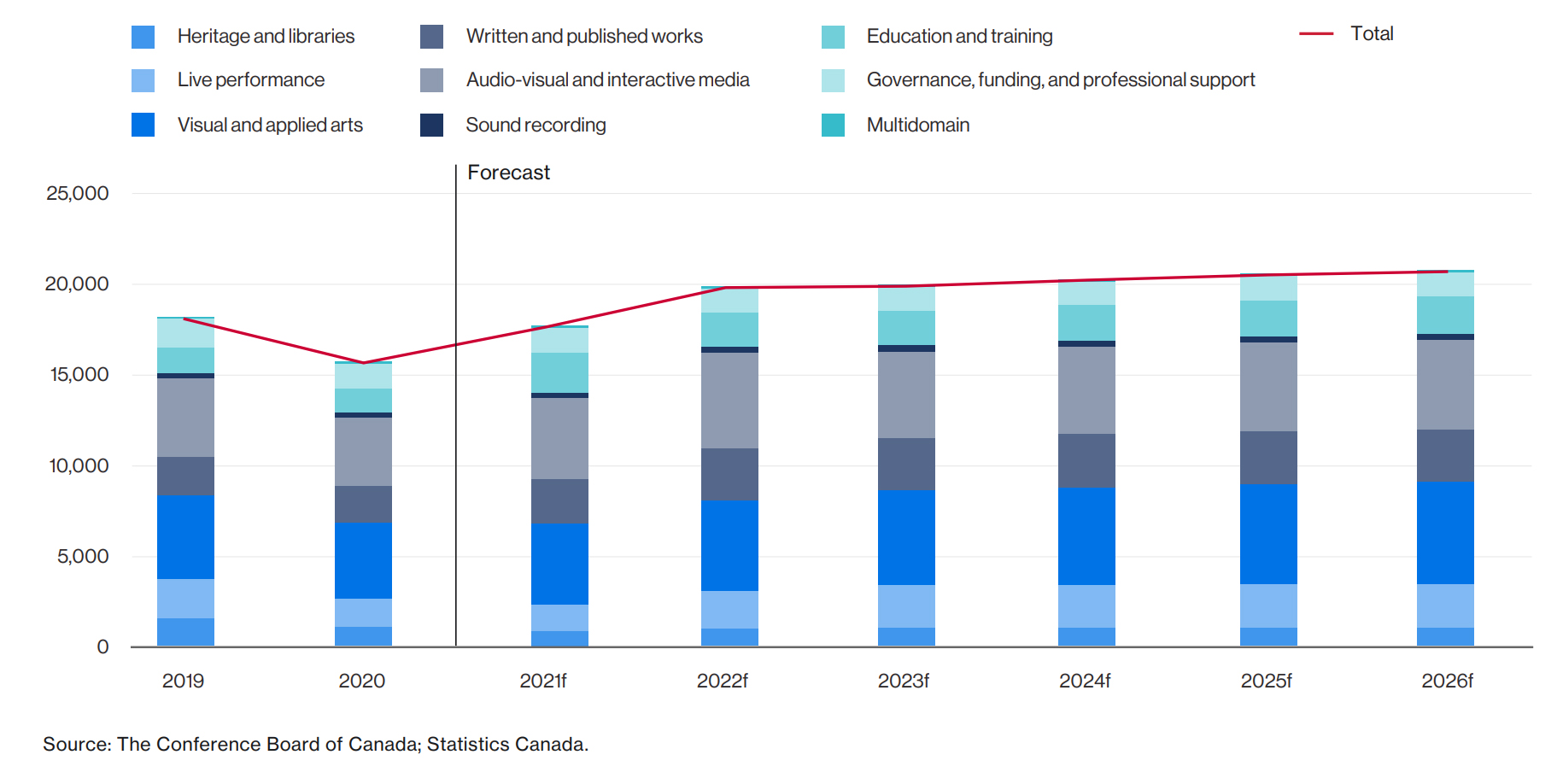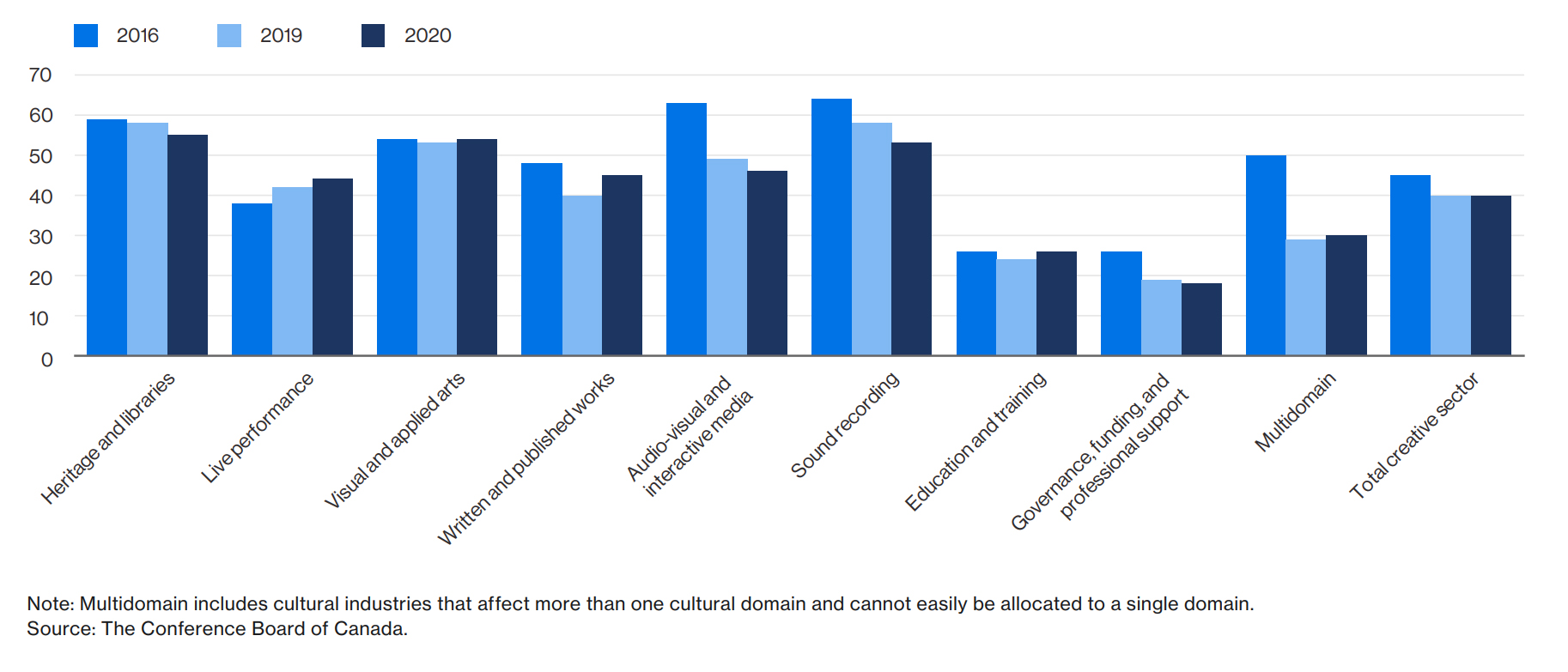Update: Impact of Calgary’s Creative Industries
A 2023 report produced for Calgary Arts Development and Calgary Economic Development by The Conference Board of Canada measuring the value of Calgary’s creative sector finds it is essential. Creative industries improve the quality of life, support the retention of workers, attract business investment and contribute to the economic vitality of the city.
The report covers creative industries in 2019 and 2020, and is an update to a previous report that looked at the economic and social impact of creative industries in 2016.
In 2019, the creative sector in Calgary:
- Employed more than 18,100 people
- Supported almost $3.4 billion in revenues for local businesses
- Generated $1.9 billion in direct GDP and $1.4 billion in wages
The creative sector in all of Alberta employed a total of 45,600 individuals and contributed $4.2 billion to GDP in 2019. This shows the important contribution of Calgary to the province’s creative sector.
A Global Pandemic in 2020
In 2020, both Calgary’s and Alberta’s cultural sector economic impact was adversely affected by the pandemic. Calgary’s cultural businesses employed 15,700 employees in 2020, which is 2,400 fewer than in 2019.
Meanwhile for Alberta, as governments imposed lockdowns in response to COVID‑19, sector employment dipped to 39,300 employees, which is 6,300 less than in 2019. In line with the decrease in employment, other metrics declined accordingly. Calgary’s cultural sector GDP was estimated to be $1.6 billion in 2020, more than $200 million lower than the previous year.
In percentage terms, employment in the cultural sector in Calgary decreased by 13.6 per cent in 2020, which is slightly lower than the overall decline in Alberta of 13.9 per cent (see Table 3). However, revenue, GDP and wages were impacted relatively harder in Calgary, all falling about 14 per cent in 2020 compared to roughly 11 per cent for all of Alberta.
Compared to the rest of the province, Calgary’s cultural sector experienced a smaller negative impact in terms of employment, but the effects on GDP and wages were larger. This is due to the outsized presence of the cultural sector situated in Calgary compared to Alberta.
Calgary Role in Alberta’s Cultural Sector
The Calgary share of cultural employment for the province of Alberta stands at 40 per cent in 2020, unchanged from 2019 but five per cent lower than in 2016. However, it remains above Calgary’s share of overall provincial employment of 27 per cent, which means that the cultural sector is more concentrated in Calgary than elsewhere in the province.
Calgary’s share of cultural employment in Alberta
Calgary on the National Stage
In Calgary, in 2020, the city’s 6,500 creative businesses represented 3.3 per cent of all businesses, which places Calgary eighth out of 12 economic regions benchmarked — the same proportion as Ottawa and slightly behind the Canadian average of 3.5 per cent.
Montreal, Vancouver and Toronto top the chart with 5.2 per cent, 4.7 per cent and 4.5 per cent of their businesses operating in the creative industries, respectively. Those top positions are not too surprising and are the same as in 2016 and 2019.
Compared to 2019, all analyzed cities saw a decline in the share of creative businesses as the creative sector was more impacted by the social distancing measures implemented by governments. However, Calgary’s cultural sector has been less impacted than the sector in other major cities. Its share decreased by a 0.3 percentage point, from 3.7 per cent in 2019. Because of that, Calgary moved up from ninth spot in 2019 to eighth spot in 2020 out of the 12 cities .
Creative industry as a share of total businesses
The Future of Calgary’s Cultural Sector
Though 2020 was the most recent employment data available at the time of reporting, Calgary’s cultural sector employment was estimated to rebound and surpass pre-COVID-19 employment levels in 2022.
In fact, in 2022, cultural employment was estimated to be higher than in 2019 in all domains except heritage and libraries, live performance and governance, funding and professional support. Live performance employment is expected to surpass 2019 levels in 2023, while employment in the heritage and libraries domain as well as in governance, funding and professional support will remain below the 2019 level until 2026.
Calgary cultural sector employment forecast out to 2026




